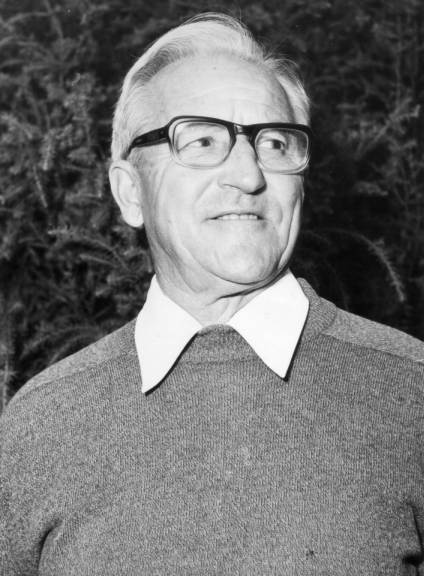 Tony Fetherston, perhaps more than any other individual, made an enormous contribution to horticultural education in the ACT. Tony Fetherston was head teacher in horticulture, and later head of the School of Horticulture at the Canberra Institute of Technology (and its predecessor institutions) from 1947 until his retirement in 1979. He occupied this position when the School of Horticulture first moved to its own campus at Heysen Street, Weston in early 1974. As head of the School ,Tony Fetherston was responsible for much of the design and planning for the Heysen Street campus.
Tony Fetherston, perhaps more than any other individual, made an enormous contribution to horticultural education in the ACT. Tony Fetherston was head teacher in horticulture, and later head of the School of Horticulture at the Canberra Institute of Technology (and its predecessor institutions) from 1947 until his retirement in 1979. He occupied this position when the School of Horticulture first moved to its own campus at Heysen Street, Weston in early 1974. As head of the School ,Tony Fetherston was responsible for much of the design and planning for the Heysen Street campus.
Click image to enlarge
Tony Fetherston’s main contribution to Canberra was as an educator, first in inculcating the high standards of relevant technical skills and know-how in those who were to contribute to horticulture’s role in Canberra’s development as a “garden city”. He was a very gifted communicator and played a mentoring role for many individuals who themselves later contributed to Canberra’s development. Through his public outreach activities in newspaper columns and radio broadcasts, he had an enormous influence on the ideas and practice of successfully growing plants in the cold and dry climate of Canberra. He was passionate about horticulture and inspired many others to pursue it with equal enthusiasm. As a horticultural researcher and experimenter, he was meticulous and set high standards, for himself as well as others.
In the early days of Canberra, Tony Fetherston seems to have been “the complete man”: he was an educator, a scientist, a public individual, and an active community-minded leader. He was an accomplished artist in water colours. He was keenly interested in interior design, and at one time taught this subject at the CIT. Not all his interests related directly to the horticultural profession. He was also very active in the Girl Guide movement and was the first man to head the Girl Guides in the ACT.
As an eminently practical man, Tony Fetherston took a broad rather than a narrow view of the role of horticulture. It was his idea to plant an arboretum at the Heysen Street campus, and the community remains grateful for this to this day. From the relatively early days of the School, courses included topics such as turf maintenance, improved fruit and vegetable production, and landscaping, each of which was important in the Canberra environment. His technical skills in plant production were of the highest order, and early on he emphasised the importance of seed propagation, at one stage conducting his own commercial seed-selling outlet. Of course, his knowledge also extended to flowers, and he was an expert on iris cultivation.
Tony Fetherston enjoyed a remarkable and well-deserved degree of recognition in own his lifetime, for his contributions to society. He was awarded an MBE in 1976 with the citation “In recognition of service to the Public Service”. In the 1979 publication produced for the 50th anniversary of the CIT gardens, Fifty Years and Growing, he is the only person to have a chapter dedicated to telling the story of his association with the garden.
The horticultural gardens at the CIT School of Horticulture in Heyson Street can correctly be seen as the culmination of Tony Fetherston’s horticultural career. Their scope, their diversity, their emphasis on a strong scientific basis for “gardening”, their incorporation of careful use of water into horticultural practices all reflect values that Tony Fetherston espoused consistently throughout his life.
The decision to respect the wishes of Tony Fetherston and his wife Margaret to scatter their ashes in the Heyson Street gardens recognised their great commitment to horticulture in the ACT. The naming of these gardens now in honour of Tony Fetherston will perpetuate this dedication, and will be a fitting and lasting tribute by the community to his lifetime work.



